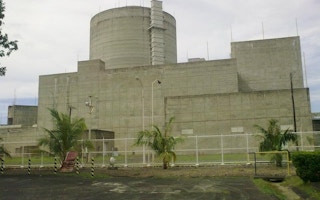Every now and then, the debate resurfaces over whether nuclear power has a role to play in Southeast Asia’s energy transition. But as Japan marks a decade since the Fukushima disaster, the region needs to move on and see the technology for what it is: a dangerous and costly distraction.
It’s obvious why nuclear power plants are appealing. Unlike wind turbines and solar panels, they can—in theory—run around the clock, uninterrupted by the whims of nature, and generate stable baseload electricity that could directly replace polluting coal.
Desperate to save itself from decline, the nuclear sector has peddled the myth that nuclear energy—clean, reliable and cost-effective as it allegedly is—is key to decarbonising the global economy.
Except it isn’t. Economics have long conspired against the industry as it built ever larger and more complex reactors. From China to the United States, projects have run years behind schedule, leading to budget overruns, and rendering the technology uncompetitive.
Things don’t get better when decommissioning costs, which can reach well into billions, are taken into account. And make no mistake, once power plants are taken down, it is ratepayers who will be hit in the pocket.
Adding to this is the expensive storage of nuclear waste. The truth is, the industry has yet to come up with a solution to permanently dispose of radioactive materials, some of which will remain hazardous for tens of thousands of years. Many experts doubt a solution will ever be found.
Until feasible options emerge, nuclear waste is usually kept on site and must be guarded and secured even after plants cease operations. This drives up costs further.
From shooting it into space to dumping it on isolated islands, all sorts of ludicrous ideas have been proposed for dealing with radioactive waste but—not surprisingly—most have been rejected as impractical, irresponsible, or too costly.
Neither is there a reliable method to warn future generations about the existence of nuclear waste dumps. Just like planet-heating fossil fuels, the legacy of nuclear power poses threats on a timescale that stretches well beyond human comprehension.
In response to economic headwinds, nuclear engineers have been busy developing cheaper, modular reactors featuring simpler designs and streamlined construction processes. But many energy experts deem these ambitions a mere pipe dream.
Despite the industry’s enthusiasm, a 2019 industry report concluded that nuclear will never make a significant contribution to tackling climate change, and that money poured into nuclear projects was diverting resources away from better ways to cut emissions.
The study, titled World Nuclear Industry Status Report, found that cash pumped into energy efficiency saved four times as much carbon as money spent on nuclear power; wind saved three times as much, and solar double.
As of 2020, the cost of generating new utility-scale solar power was US$30-60 per megawatt-hour in Europe and the United States, and as low as US$20-40 per megawatt-hour in China and India, International Energy Agency data shows. Nuclear power cost between US$112 and US$189 in 2019. The technology is the epitome of a stranded asset.
As renewable energy costs keep dropping, nuclear surely isn’t worth the hassle, and despite what the industry says, it isn’t needed.
A 2020 report by research group Wood Mackenzie showed most markets in Asia Pacific will see the levelised cost of electricity (LCOE) for solar and wind fall below coal’s this decade. Thailand and Vietnam are expected to join China with lower clean energy costs compared to coal as early as this year.
Meanwhile, it has been proven that electricity systems can accommodate larger shares of intermittent renewables without experiencing power cuts in countries like Denmark, which sourced 47 per cent of its electricity from wind in 2019, and Germany, where the share of renewable energy in the generation mix climbed to 46 per cent last year.
There are plenty of ways to handle volatile clean energy output. In Southeast Asia, it will require both investment in transmission infrastructure and backup solutions, but it can be done. Battery storage is becoming increasingly viable, with the average cost of a lithium-ion battery pack dropping 88 per cent over the past decade. In Asia Pacific, solar projects coupled with storage are estimated to become competitive with gas by 2026.
In the coming years, Southeast Asia will also continue building out the Asean Power Grid, enabling countries to transfer surplus electricity to neighbours. Wider geographic distribution of clean power generation will ensure that diverse green energy sources complement each other. In addition, energy planners could deploy pumped-storage hydropower or modify consumer demand to adapt to fluctuating electricity supply.
And by the time Southeast Asia reaches similar levels of wind and solar penetration as European nations, novel solutions will emerge. Green hydrogen, which will unlock potential to buffer intermittent daily and seasonal power generation and decarbonise heavy industry, is projected to be competitive with fossil fuels in Japan, Germany, and Australia by 2030. Technology transfer and conducive policies will ensure that Southeast Asian nations will not be far behind.
Last year, an energy expert from Indonesia told me that adding renewables alone may work well in Europe’s advanced economies, but that Southeast Asia’s rapid energy demand growth—which is among the fastest in the world—called for other sources of power. “Renewables have never been the solution to provide energy for developing countries,” he said.
But if the region needs energy so urgently, one has to wonder why governments would toy with the idea of building nuclear energy plants that take five to 17 years longer to build than utility-scale solar or on-shore wind power. Slow coal power development has already prompted Vietnam to pivot towards cleaner alternatives. Why replace one sluggish technology with another?
I’m not saying nuclear projects operating elsewhere in the world today should be switched off tomorrow. By all means, keep them running until countries have the means to replace them with green alternatives. But when building new capacity, economics and project timelines simply do not work in the sector’s favour.
Yet costs and the industry’s inertia aren’t the only reason why nuclear energy never gained much traction in Southeast Asia. There is also the sector’s poor reputation it earned from the two major nuclear disasters that occurred over its 70-year history.
According to the World Nuclear Association, nuclear power plants can be designed to withstand earthquakes. Once the ground shakes, they shut down, as did 11 nuclear plants in Japan when a magnitude-9 quake hit in March 2011.
That didn’t prevent the tsunami that followed from broaching the Fukushima power plant’s sea defences and causing the failure of emergency generators required to keep the reactors cool. The subsequent meltdowns prompted authorities to evacuate more than 154,000 people living in surrounding towns, and estimates put the clean-up costs at US$300 billion.
Earthquake-proofing wouldn’t have averted the 1986 Chernobyl disaster either, which was the result of a flawed reactor design combined with human error. From wildfires to floods, there are myriad other potential risks that might jeopardise reactor safety.
Can power plant operators ever completely rule out the risk of nuclear accidents? Every nuclear energy expert I have spoken with conceded they can’t.
The Philippines is the only Southeast Asian state to have built a nuclear power station, 100 kilometres west of its capital Manila. Completed in 1985, the Bataan Nuclear Power Plant cost over US$2.3 billion, and it never went into operation.
In the wake of Chernobyl, Philippine authorities decided it was safer to mothball the facility. It wasn’t until 2008 that the loan for the project was paid off, the same energy analyst from Indonesia told me.
Even during construction, the project was mired in controversy. Plagued with problems, the venture quickly saw cost estimates balloon to levels three times higher than the original proposal, which promised a reactor with double the generation capacity the country ended up with.
Other countries in the region have floated proposals for nuclear power, but most have been abandoned due to rising costs and safety concerns. Vietnam came closest to constructing its first nuclear power station, but it scrapped its plans in 2016. Malaysia said in 2018 it had no plans for nuclear power, while Thailand’s ambitions to develop a 20-megawatt research reactor have been delayed for two decades.
Only Indonesia and the Philippines have proposed regulatory changes to revive dormant nuclear energy plans, despite a suspected case of nuclear waste dumping in a residential area near Jakarta last year. The Philippine government is also mulling turning on the Bataan plant, although that will take some convincing of the public.
Ultimately, the country would be better off keeping the site what it currently is: a tourist attraction.









